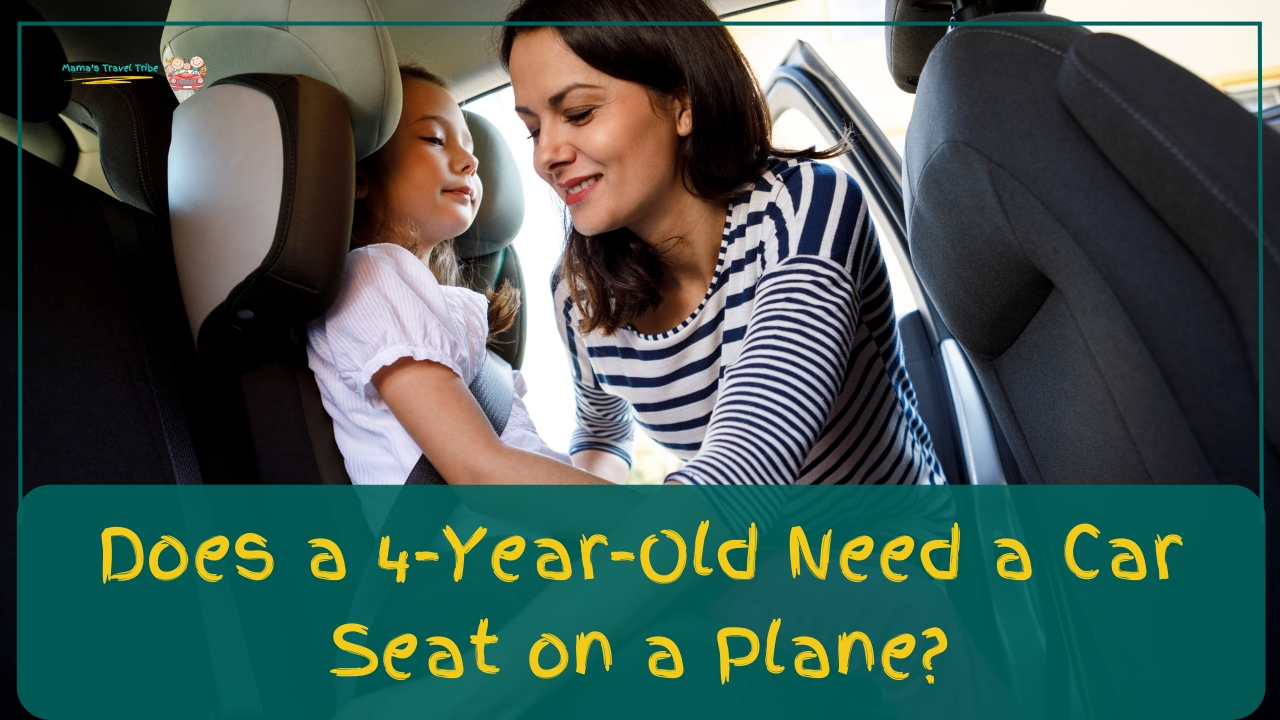“Does a 4-Year-Old Need a Car Seat on a Plane?” is a topic often discussed in parenting forums and travel blogs. Absolutely, your four-year-old needs a car seat for air travel, and I’m discussing why in this article.
Keep reading for all the details, along with the top car seat picks and practical tips for a worry-free journey!
Does a 4-Year-Old Need a Car Seat on a Plane? (FAA Guidelines for Children)
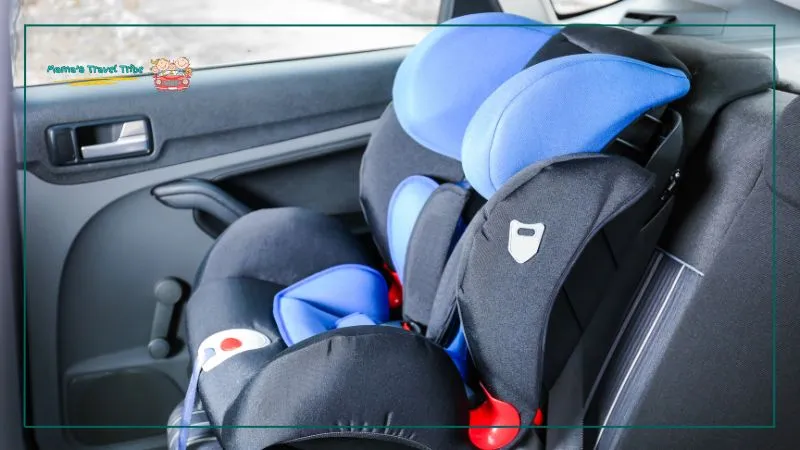
A 4-year-old does not need a car seat on a plane, but using one is recommended for safety. Child safety seats designed for air travel provide extra security during turbulence. Ensure the car seat fits properly in the airplane seat, and check with the airline for any specific requirements.
FAA Guidelines for Kids Air Traveling
When we talk about flying with little ones, it’s super important to know what the Federal Aviation Administration, or FAA, says about it. I’ve looked into this a lot because, let’s be honest, we all want our trips to be as smooth and safe as possible, especially when we’re up in the air with our kids.
So, here’s the deal: The FAA highly recommends that children under 40 pounds use a car seat on planes. Now, you might be wondering, “Is it a must?” Well, it’s not a requirement, but think about this—car seats are made to protect kids in cars, and planes can be just as bumpy, right?
That’s why using a car seat for your 4-year-old makes a lot of sense. It keeps them snug and secure during takeoffs, landings, and those unexpected rough patches in the sky.
Who Should Use Car Seat on Plane?
Car seats are not for every child. Wondering, Does a 1-year-old need a car seat on a plane? Yes, it is recommended for a 1-year-old to use a car seat on a plane for safety and proper restraint during the flight.
People also ask, “Does 2 year old need car seat on plane Delta?” Well, if your child is under two years old, they can actually fly on your lap. The question now arises, “Does a 3 year old need a car seat on a plane?” Yes, they do.
Does a 6-year-old need a car seat on a plane? No, a 6-year-old does not need a car seat on a plane, but using one can provide additional safety and comfort.
Remember that a car seat isn’t just about comfort—it’s about safety. The FAA’s guidelines are clear; they want your kids to be as safe in the sky as they are on the road.
And you know what? It’s always good to check with your airline, too, because they might have their own rules. Some airlines love it when kids use car seats because it makes their job easier, knowing the little passengers are safe and sound.
In my experience, I’ve always felt more at peace using a car seat for my child. It’s like having an extra layer of safety, which is never a bad thing when you’re flying high!
How to Choose the Right Car Seat for Airplane Travel? (Find Out)
Choose a car seat labeled for airplane use, ensuring it fits the aircraft seat dimensions. Opt for a lightweight, easy-to-install model. You should also check that it’s certified for your child’s weight and height. It’s also recommended that airline-specific regulations be verified and a seat with a compact design considered.
Know What You Are Looking
First things first, always look for a car seat that’s FAA-approved. This is super important because not all car seats fit the bill for air travel. You can usually find a label that says “This restraint is certified for use in motor vehicles and aircraft” right on the car seat. This label is your green light that says it’s good to go.
Consider Some Points During Shopping
Now, when you’re shopping for a travel car seat, keep these things in mind:
- Weight and Size: You want something lightweight because you’ll be carrying this through the airport. Models like the Cosco Scenera Next or the Evenflo Tribute LX are great because they’re not just light, they also don’t take up too much space.
- Ease of Installation: The simpler, the better because you don’t want to be wrestling with a car seat while boarding.
- Comfort: Your little one is going to be in this seat for the whole flight, so make sure it’s comfy. A good seat fit is crucial for their happiness and yours.
Speaking of specific models, the Cosco Scenera Next is a favorite among traveling parents. It’s not just light; it’s also pretty compact, which makes it a breeze to carry around and fit into those airplane seats.
Another great option is the Maxi Cosi RodiFix, known for its ease of use and comfort, making it an excellent choice for longer flights.
Remember, whatever car seat you choose, it has to be a good fit for your child. This means it should match their weight and height. A snug fit ensures the car seat performs well and keeps your child safe.
Get a Car Seat Bag
I also recommend having a car seat bag when traveling. It’s great for keeping the car seat clean and makes it easier to carry around the airport. Some bags even have wheels—talk about a travel hack!
How to Properly Install a Car Seat on an Airplane? (Step by Step)
To properly install a car seat on an airplane, ensure it is FAA-approved and fits in the seat. Position the car seat forward-facing in a window seat, use the airplane seat belt to secure it, and tighten it firmly. Confirm with the flight attendants if you need any additional assistance.
Check If Your Car Seat is FAA-Approved
Before you travel, make sure your car seat is approved for airplane use. Look for a sticker on the seat that says it is FAA-approved. This is important because not all car seats can be used on airplanes. If your car seat isn’t approved, you may not be allowed to use it on the plane.
Choose the Right Seat on the Plane
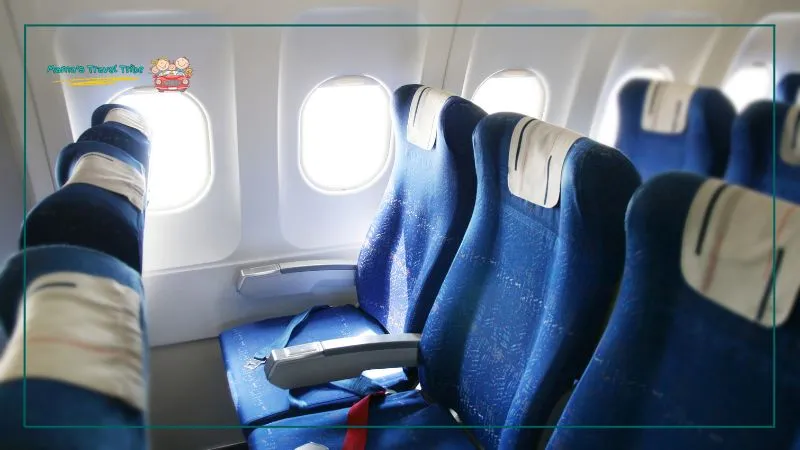
People often ask, “Do you have to pay for a car seat on a plane? No, you do not have to pay extra for a car seat on a plane, but you need to purchase a separate seat for your child to use.
When booking your flight, choose a window seat for your car seat. This ensures it won’t block the aisle, making it easier for other passengers to move around. Car seats should never be placed in exit rows for safety reasons. Some airlines allow pre-boarding for families, giving you extra time to install the seat.
Install the Car Seat Forward-Facing
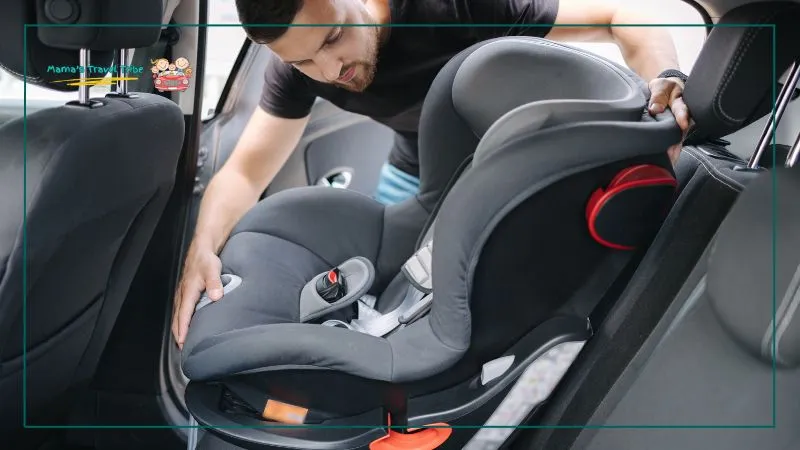
Place the car seat forward-facing in the airplane seat. Most airlines require this position for safety. Make sure the car seat is snug against the back of the airplane seat. If your child is an infant, you might be able to use a rear-facing seat, but always check with the airline beforehand.
Use the Airplane Seat Belt
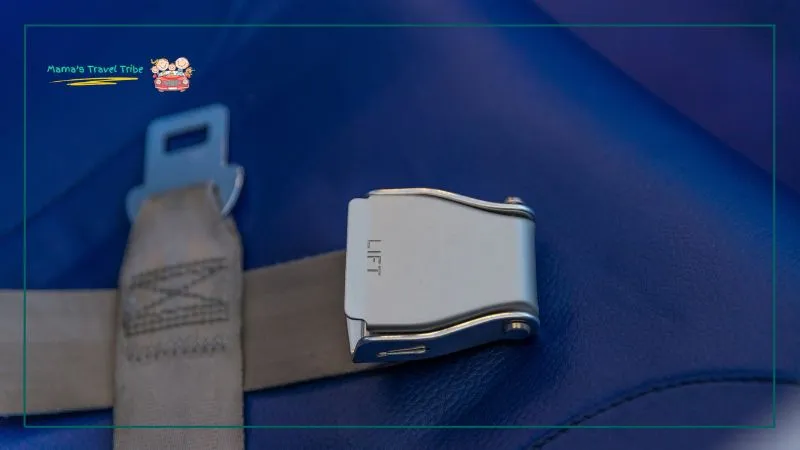
Thread the airplane seat belt through the car seat’s belt path. Pull the seat belt tight. Make sure the car seat doesn’t move more than an inch side-to-side or front-to-back. If it feels loose, tighten the seat belt more. This step is crucial to ensure your child’s safety during the flight.
Confirm with Flight Attendants for Additional Assistance
After installing the car seat, ask a flight attendant to check it. They can confirm if it’s properly installed and offer assistance if needed. They are trained to help with these situations, so don’t hesitate to ask. Ensuring the car seat is correctly installed is important for a safe and smooth flight.
Now, I know what you might be thinking—what about booster seats or travel vests like the RideSafer Travel Vest?
Well, booster seats are typically not recommended for use on airplanes because they require a shoulder belt, which planes don’t have. The RideSafer Travel Vest, however, can be a good alternative for older children who have outgrown traditional car seats but still need some additional support.
One last tip: Keep a friendly dialogue with the flight attendants. They’re there to help, and they can offer extra guidance if you’re unsure about anything. Plus, they appreciate knowing you’re committed to safety just as much as they are.
Once you’ve figured out the car seat situation for your 4-year-old, you might start thinking about where to take your little traveler. For some fantastic ideas, check out 20 Top Travel Destinations for 2-Year-Olds: A Parent’s Guide.
4 Benefits of Using a Car Seat Versus Airline Seats Alone
Using a car seat on an airplane has many benefits, including better safety and comfort for your child. Car seats offer proper support and security, reducing the risk of injury during turbulence. They also help children feel more familiar and relaxed, making the journey smoother for both kids and parents.
Safety First: Why Car Seats Are Superior for Young Children
First and foremost, child safety is our top priority, especially when we’re flying. While airplane seatbelts are great for adults, they don’t quite fit the bill for our little ones. These belts aren’t designed to secure small children effectively. This becomes particularly concerning in situations like turbulence.
A car seat ensures your kid is held securely in place. This reduces the risk of injury during unexpected rough patches.
Comfort and Support During Travel
Beyond safety, child restraint systems such as car and booster seats are crucial in keeping your child comfortable. Airplane seats are not made with the long-term comfort of young travelers in mind. Kids seated in a car seat enjoy better posture support.
Portability and Convenience
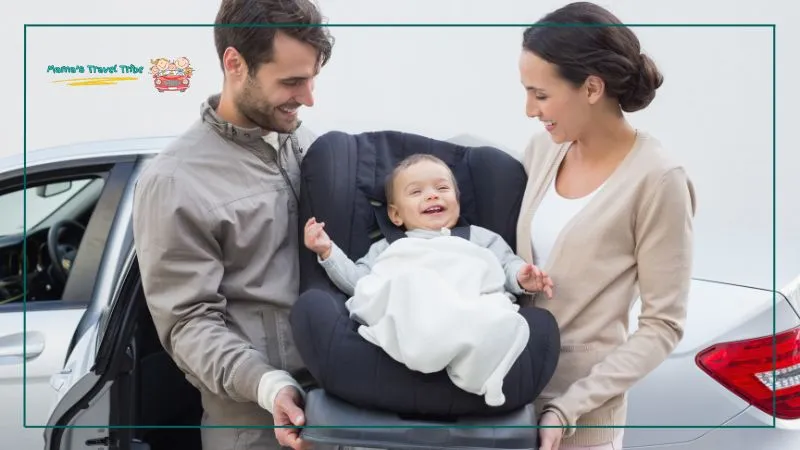
Travel car seats are specifically designed for the on-the-go family. They are generally lighter than regular car seats. That’s why moving through the airport can be a breeze.
Having a travel car seat also means you’re prepared with a safe seat for your child, not just on the plane but also in rental cars. It’s all about making travel seamless.
Peace of Mind for Parents
Lastly, there’s the mental comfort that comes with knowing your child is safely secured. Using a car seat that complies with all FAA guidelines and airline regulations not only meets safety standards but also offers you peace of mind.
Common Challenges and Solutions When Traveling with Car Seats
Common challenges when traveling with car seats include heavy weight, difficulty in installation, and limited space. To overcome these, use a lightweight, FAA-approved car seat, practice installation at home, and book a window seat for more room. Additionally, seek assistance from flight attendants to ensure proper setup.
Fitting the Car Seat into Airplane Seats
One of the biggest challenges you might face is ensuring the car seat fits properly into the airplane seat. Note that not all car and airplane seats are created equal.
Here’s what you can do:
- Check Airline Compatibility: Before you travel, it’s a wise move to check with your airline about their car seat policies. Some airlines have specific requirements or even provide dimensions for the seat space.
- Choose an FAA-Approved Seat: As I mentioned earlier, ensure your car seat is FAA-approved for air travel. These seats are generally designed to fit more easily into airplane seats.
Dealing with the Weight and Bulk of Car Seats
Traveling with a bulky car seat can be daunting, especially if you have multiple children and luggage to manage. Here’s how to tackle this:
- Lightweight Travel Car Seats: Invest in a lightweight travel car seat like the Cosco Scenera Next, which is designed for easy portability without sacrificing safety.
- Car Seat Bags with Wheels: Consider a car seat bag that has wheels. This can make transporting the seat through the airport much simpler and less physically demanding.
Installation on the Plane
Installing the car seat on the plane can sometimes be tricky, particularly if you’re in a hurry during boarding. Here’s how to make it smoother:
- Practice Before You Go: Try installing the car seat in different scenarios at home before your trip. This practice will make you faster and more efficient when it’s time to board.
- Board Early: Take advantage of early boarding for families. This extra time can reduce stress and give you the space you need to install the seat properly.
Keeping Your Child Happy in Their Car Seat
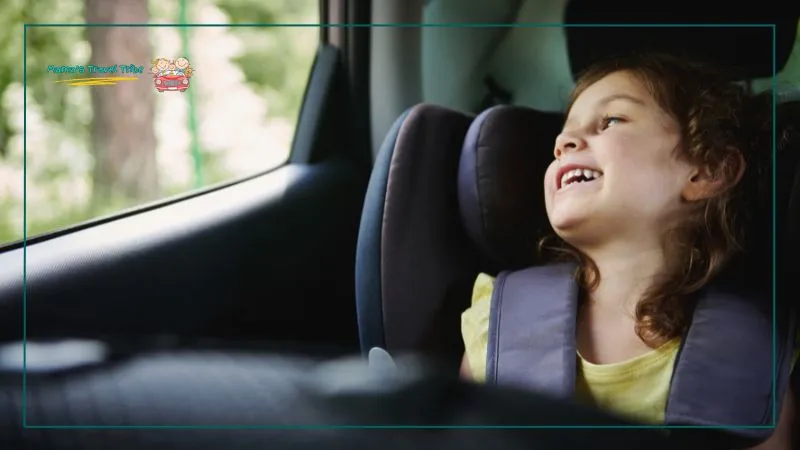
Let’s face it: keeping a young child happy and content in their seat for hours can be challenging. Here are a few strategies:
- Comfort Items: Bring along their favorite small blanket or a soft toy. Familiar items can help soothe and comfort your child during the flight.
- Snacks and Entertainment: Pack plenty of snacks and load a tablet with their favorite shows or games. Distractions can go a long way in keeping them calm and seated.
Handling Gate Check and Airline Procedures
Sometimes, you might decide to gate-check your car seat or use a car seat travel bag. Keep these tips in mind:
- Label and Protect: Ensure your car seat is well-labeled with your contact information.
- Verify with Gate Agents: Double-check with gate agents about the best way to handle your car seat if you’re not using it on the plane to ensure it’s treated with care.
By addressing these common challenges with practical solutions, you can make traveling with a car seat a lot more manageable and stress-free.
Recommended Car Seats for Air Travel by Safety Experts
When it comes to choosing a car seat for air travel, you want the best for your child—something that’s not only safe but also easy to handle. Based on my research and recommendations from safety experts, here are some of the top car seats you can consider for your next flight.
Cosco Scenera Next Convertible Car Seat
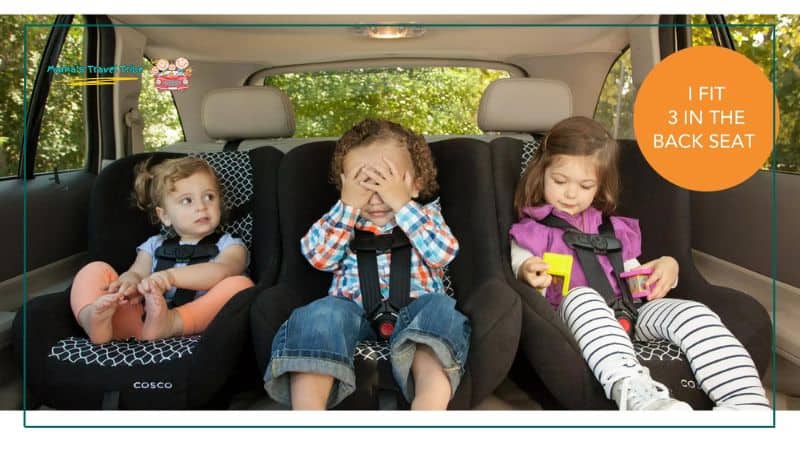
This seat is a real favorite among traveling families. Why? Well,
- It’s incredibly lightweight
- Easy to install
- Doesn’t break the bank.
Plus, it’s compact enough to fit comfortably in most airplane seats. The Cosco Scenera Next ensures your child is secure, whether you’re using it in rear-facing or forward-facing mode.
Maxi-Cosi RodiFix Booster Car Seat
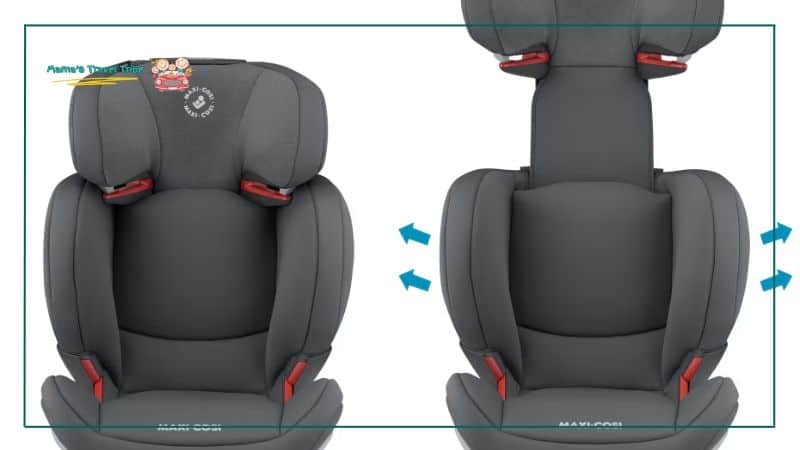
For older children, the Maxi-Cosi RodiFix is a fantastic choice. It’s designed for ease, with a quick and simple belt routing system that makes installation a breeze.
Though not for the youngest travelers, it’s ideal for kids who still need that extra boost for proper seatbelt positioning.
RideSafer Travel Vest
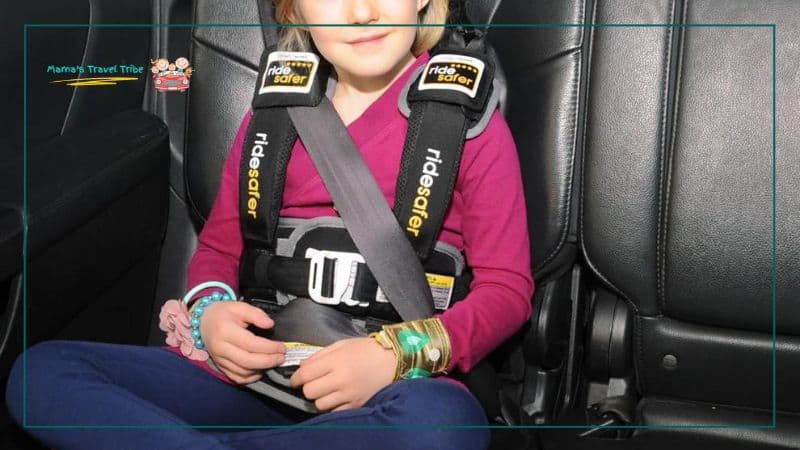
If you’re looking for an alternative to traditional booster seats, the RideSafer Travel Vest might be just what you need. It’s compact and easy to pack. Furthermore, it is also certified for use in both cars and airplanes.
This makes it perfect for families who need a flexible solution for traveling with an older child.
Graco Extend2Fit Convertible Car Seat

The Graco Extend2Fit features an extendable base that offers extra legroom, a bonus for keeping taller children comfortable in a rear-facing position. Its robust installation system ensures the seat stays securely in place. This gives you peace of mind throughout the flight.
Some more recommended seats are:
- Cosco finale dx 2-in-1 booster car seat
- Hiccapop Uberboost inflatable booster car seat booster ca
- Maxi Cosi Romi convertible car seat
Let’s now wrap up with some practical tips to make your air travel experience as smooth and stress-free as possible:
Tips for Making Air Travel Easier and Safer for Children and Parents
To make air travel easier and safer, arrive early for pre-boarding, bring snacks and toys for entertainment, and use a child-friendly app for in-flight activities. Ensure your car seat is FAA-approved and securely installed. Lastly, essentials like diapers and wipes should be easily accessible during the flight.
Here are some more details:
- Preparation is Key: Pack all your travel car seat accessories, such as a car seat travel bag, Ridesafer travel car seat ride safer travel vest, and installation guides, the night before. Being prepared can greatly reduce travel day anxiety.
- Familiarize Your Child with the Car Seat: Let your child sit in the car seat at home before the trip. This familiarity can help them feel more comfortable when it’s time to sit in it on the plane.
- Check for Updates on Airline Policies: Airlines can change their policies regarding child restraint systems American airlines, and booster seats. A quick call or email to confirm current rules can save you time and trouble at the airport.
- Gate Checking: If you decide to gate check your car seat, make sure to ask about protective measures or special handling to keep it safe from damage during the flight.
Using these expert-recommended car seats and following these tips can help ensure that your travel is not only safe but also enjoyable.
FAQs
At What Age Can a Child Sit in an Airplane Seat?
A child can sit in an airplane seat as early as 2 years old. Always keep in mind that using a car seat is recommended for better safety and support.
Are All Car Seats Suitable for Airplane Use?
Not all car seats are suitable for airplane use. Always look for a label stating that the car seat is approved for use in both motor vehicles and aircraft.
How Do I Ensure My Car Seat Is Installed Correctly on a Plane?
Make sure to follow the seat’s installation instructions. Use the airplane’s seat belt to secure the car seat and check that it does not move more than an inch side-to-side or front-to-back.
Can I Bring a Booster Seat on a Plane?
Booster seats are typically not approved for airplane use because they require a shoulder belt, which most airplane seats do not have. Consider using a travel vest or another FAA-approved device for older children.
What Should I Do if My Car Seat Does Not Fit in the Airplane Seat?
If your car seat does not fit in the airplane seat, you may need to seek assistance from the flight attendants for a suitable solution, such as using an extender or repositioning the seat.
Conclusion
Wrapping up, here are the top takeaways for flying safely with young children:
- FAA Approves: The FAA strongly recommends car seats for children on planes for enhanced safety.
- Right Fit Matters: Choose a lightweight, FAA-approved car seat that fits well in airplane seats.
- Secure Installation: Ensure the car seat is tightly installed using the airplane seat belt.
- Comfort is Key: A proper car seat offers more comfort and stability, helping your child relax throughout the flight.
- Be Prepared: Check airline policies on car seats ahead of time to avoid any travel day surprises.
This guide should now have you well-prepared to ensure your little one’s safety and comfort on your next flight!

